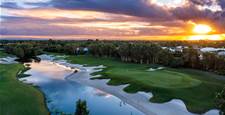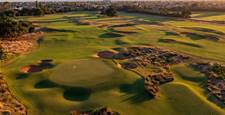Over the past two decades, northern Tasmania has emerged as a world-class golf destination offering a mix of internationally acclaimed layouts and fun, picturesque courses anyone can play.
The round opens with a strong par-5 and par-4 combination. But the real fun begins at the 271-metre par-4 4th, which is known as ‘Homestead’ as the ruins of the original Barnbougle homestead lie beneath the dunes on this hole. The prevailing wind is into your face here but long hitters might be tempted into blasting a drive over a massive blowout bunker on the right edge of the fairway in a bid to find the punchbowl green. It is a huge risk but the reward is an almost certain birdie if your drive carries far enough.
The course winding back to the clubhouse from the 5th tee onwards, with each fairway occupying a narrow corridor between large dunes. These corridors rise and fall with the natural lie of the dunes land creating a real test for each player’s shot-making ability.

The inward nine is more open but the fairways and greens are easily more affected by the undulating land they have been laid upon. It is hard to pick a standout out hole on the back nine but the stretch of holes from the short par-4 15th through to the 400-metre par-4 18th is great finish to a course that offers great variety from the first shot to the last.
Some early critics suggested the course was too isolated to be financially viable. They couldn’t have been more wrong as golfers from near and far trekked to Barnbougle Dunes time and time again, ensuring its success and planting the seed of thought of building a second course.
Almost six years after the Dunes opened for play, Barnbougle Lost Farm was born. A month later Golf Australia magazine ranked Lost Farm in the top-10 courses in the nation, a lofty position where it remains a decade on.
Designed and built by American design firm, Coore and Crenshaw, Lost Farm features 20 holes (with two extra par-3s on the inward half) laid out alongside the beach and inland amongst majestic sand dunes. Despite being neighbours, Lost Farm is significantly different to Dunes, which adds to the appeal of Barnbougle as a golfing destination.
“I think some see it as being better than Barnbougle Dunes because it offers a greater variety of play as the holes run in different directions,” says Mike Clayton, co-designer of the original Barnbougle course. “Barnbougle Dunes follows the low land between the dunes and this dictated that the holes head predominantly east and west. Lost Farm’s holes go to all points of the compass and when there is wind involved in a location like this it means no two rounds can ever possibly be the same.”

Lead architect Bill Coore, who has a reputation for minimalistic course design,
was hands on in the creation of Lost Farm, which boasts some very good, some great
and some absolutely brilliant holes. There isn’t a weak offering among them and during the past decade some of the best holes here have been elevated to the world stage as choice selections.
One of those holes is the short par-3 4th, which calls for a tee shot to be hit parallel to the beach out to a small point that overlooks Little Forester River, the ocean and the original Barnbougle course.
The 5th hole is even better. Measuring nearly 400 metres from the back markers, the green is visible off in the distance – sitting hard up against the river bank. The longest drivers in the game, in the right wind conditions, might take dead aim at the green. But the play for 99.9 percent of the golfing population is left, away from the river, and on a dogleg right fairway that follows a valley around the base of a 30-metre high sand dune before rising to the green sitting among wild bunkers and dunes.
Designed by Bill Coore, Bougle Run has been created to add even more fun to a Barnbougle visit and, in time, will be considered among the best short courses in the world.
Another towering dune is a feature of the downhill par-4 14th hole. Measuring just 263 metres from the tips, the 14th is flanked down the right by this majestic dune but really only comes into play when the golfer – tempted to drive the green by carrying the right fairway bunkers – loses their tee shot on the prevailing westerly wind. With a generous fairway to be found left of these bunkers, it can be a costly mistake and a great example of a hole where a player chasing hard for a birdie three can quite often finish with a bogey or worse.
Barnbougle continues to grow with the official opening on March 31 of its new short course, Bougle Run. The 14-hole course consisting of 12 par-3s and two short par-4s covers a wild landscape of dunes and sandy blowouts alongside the 8th, 9th, 10th and 11th holes of Lost Farm. Designed by Bill Coore, Bougle Run has been created to add even more fun to a Barnbougle visit and, in time, will be considered among the best short courses in the world.

While any golfer heading to northern Tasmania will have Barnbougle on their itinerary, the region offers plenty more golfing options to entice you into staying a little longer.
If you want to be playing golf within an hour of leaving the airport, Launceston Golf Club is the ideal course to venture to.
The course at Kings Meadow – the oldest 18-hole layout in Tasmania and the fifth oldest in Australia having been established in 1899 – is just ten minutes’ drive from the airport and many visiting golfers to Launceston make this course their first, or last, port of call.
The par-72 measures just 5,965 metres from the back markers but the challenge lies in keeping your ball on the fairway between the long stretches of mature tree-lined rough. This is one reason why the club has hosted the Tasmanian Open and Amateur many times.
Launceston’s strength is in the quality of its shorter holes, and there is no better short par-4 on the course than the 312-metre 12th. The tee shot here is played out of a tree-lined chute to a fairway that sits diagonally to your approach and is receptive to a left-to-right ball flight, which will help avoid the three fairway bunkers that significantly narrow the landing area. A short iron or wedge into the relatively new green complex must be accurate to avoid trickling into a pond left or one of the two bunkers right.

Bunkers are also the main hazard on the memorable par-3 13th, which is known as ‘Spine Cop’. It is not overly long at 152 metres from the championship pegs, but the key is to successfully select a club that will carry your tee shot across a tree-lined valley to the heavily bunkered green.
There are three more courses within close proximity of Launceston – the Peter Thomson and Mike Wolveridge-designed Country Club Tasmania, the enjoyable Riverside Golf Club and picturesque Mowbray Golf Club.
Mowbray, which dates back to its nine-hole roots in 1934, is a layout of hills and dales that offers tremendous variety from one hole to the next, while the views of the city to the south and Tamar Valley are pretty good too.

You are eased into the round here with two short par-4s, with the best of them being the 319-metre 2nd. Your drive here must carry a lake in front of the tee and find the fairway that veers right and climbs gradually uphill toward the green. Tall stands of pines to the right and gum trees to the left flank the fairway, while the relatively small green is set in an amphitheatre and is protected by two bunkers in front. This was certainly one of my favourite holes at Mowbray.
Related Articles

Drinks With... Ricky Ponting

Barnbougle Dreamin': They built it, they came, they're still coming



.jpg&h=115&w=225&c=1&s=1)




_15th_hole.jpg&h=115&w=225&c=1&s=1)




